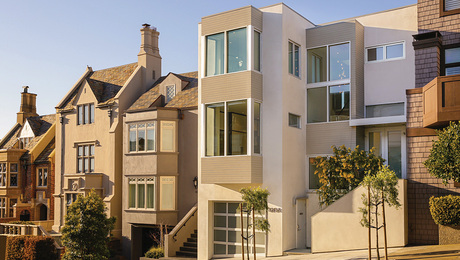How much better is it to use water resitant drywall (“green board, aquablock,”) vs. the regular stuff in a bathroom? I used it in the previous bath that I did, but am just wondering after (enamel)painting etc. whether it’s worth double the price or if using a fairly waterproof paint is just as good.



















Replies
I remodeled several bathrooms last year which required gutting around an existing tub, drywalling, and installing surrounds. I went for the greenboard, though here in CT it is only 2 bucks more per sheet (~$7.50 per.) It seemed like cheap insurance. I also noticed that the greenboard appeared stiffer and less prone to cracking than the regular stuff. I had no trouble priming or painting, and so far, no leaks. I used J-channel on the edge around the tub, and it is recommended that edges near potential water sources be coated with a motar-like compound. I tried, but it wouldn't stick. Also, ensure the drywall is about 1/4" off the tub lip to prevent wicking at the ends. I also used setting compound. At the time, someone suggested using cement board, but the job was almost completed by then.
The only difference is the color and price. 5/8" is just as good. If your doing it on the ceiling, the framing for M/R should be 12" OC. Did an airplane hanger a few years ago, the ceiling and the walls. Got some rain, the roof leaked. Got the scaffolding out, proceeded to saw a small hole and the entire 12' board came down me, went over the side of the scaffold and held on. I was 12' up!
M/R is "moisture resistant" not "water resistant" - meaning it holds the moisture more. At the hangar, we took off all the board, still 3 days aftyer it rained, they were very very heavy - I couild not belivee it.
For the utmost protection around a tub, get "Dens-Shield" - it's drywall with a layer of plastic over it. Do not tape between the seams if you have any, it comes in 4 x 8, use silicon caulk on the seams - that's water proof!
To test M/R board, soak it in water for an hour - then see what happens to it!
i have done 100's of bathroom renos mostly including a new tub. I would never use any kind of drywall product in the tub area. Why take the chance, compared to the total price of the job and the consequences of drywall becoming wetwall, cement board is cheap insurance and should last forever. Around here(Ontario, Canada) its awailable in 5x5 sheets. How simple can it get.
Supprizing responses.
I always want green board in baths that have showers. Its more the moisture from the shower that damages drywall. Ive got vent light fans with a leg going to the vanity light so when you light the room you get a fan. I build a new rental and got mold in all the windows. Another one didnt have a vent fan and it damaged the drywall. [which was regular drywall] I once seen green board in hospital showers, but they were epoxy painted. Normal use with out water standing against it such as a spa, its normal practice to go green.
Tim Mooney
i would never use it again in a shower-----stick to dens-shield-----as for the rest of the bath, it is a waste of money---i am with you, just use oil paint in the bath and nothing will penetrate the drywall anyway---don't you remember the article in the magazine years ago about the differences of the 2-----i do
CBU in shower/bath surround and anywhere else tile will be installed. Regular drywall on remaining walls and Ceiling primed with BIN seal.
Drywall in shower/tub surround is only asking for trouble."Don't take life too seriously, you are not getting out of it alive"
Yep.
Tim Mooney
Its almost a silly question......Certainly use MR in areas where heavy moisture pursits but use Wonderboard or any CBU in the shower bath area. I personally like "Wonderboard" over everything else CBU wise. Cost is insignificant unless youre doing airplane hangers.
Be hung LOL
Namaste
Andy
"Attachment is the strongest block to realization"
http://CLIFFORDRENOVATIONS.COM
Be hung
Words to live by, words to live by :)
Hey Andy,
Use M/R ya say, then why does USG, National Gypsum, etc. state on the specs for M/R that the framing on the ceiling on the ceiling should be minimum 12 inches? M/R is a sponge, it holds the water/moisture and does not let it go, thus ity gets heavy and tends to sag.
Reasons for what type of backer board under shower tile/marble, whatever:
1) Strong and permanent backing.
2) Should the tile grout leak, a backer is optimum that will not allow the water sepage to penetrate it.
The only one that meets this criteria is Dens-Shield, it's fiberglass reinforced and does not allow water to penetrate. Cement board does allow water thru!
As for the rest of the bath, yes an oil based primer and some good semi-gloss paint and no problem. Of course, some sort of venting whether fan or window is a must, unless you want the vanity to desintigrate too.
You guys must be talking about tiled tub surrounds. What do you use on the walls above, and the ceiling above, an acrylic or gelcoat one-piece tub/shower unit?
For walls at tub/showers and showers that are tiled, in my little community here in the Adirondacks, most everyone has gone to using plain drywall over studs, then doing the Schluter membrane set in thinset, before tiling. Everyone is saying the membrane will outlive us all, while keeping any water from ever getting through to the substrate, whether it's white, green, cement, or anything.